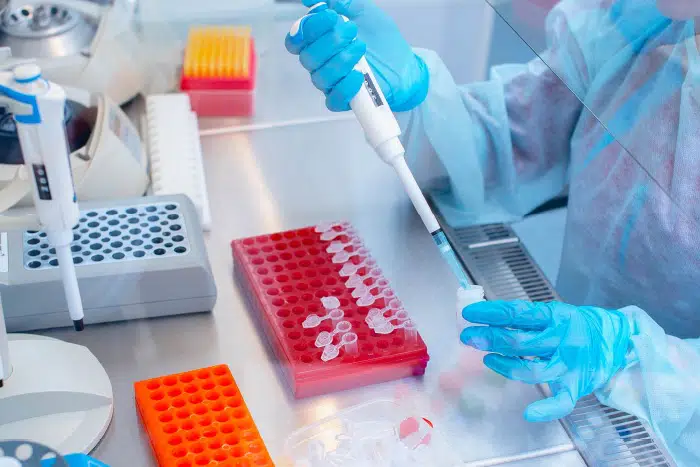How do the COVID-19 tests and molecular tests work?

You probably have heard a lot about both SARS-CoV-2, the virus that caused Covid-19, and tests for COVID-19. Any virus needs a host to replicate and to generate more viral replicas as the virus seizes the host’s cells. The genomic material remains in the body while the virus is still copying and reproducing for the SARS-CoV-2 is ribonucleic acid (RNA).
Molecular COVID-19 tests are can be conducted on any genetic material but are typically conducted on specimens collected from the respiratory tract. In most cases, the sample is taken with a nose or throat swab. Molecular tests detect evidence of this replication process that more viruses are being made to diagnose an active infection of coronavirus Covid-19.
Researchers can also test using a saliva sample depending on the specific molecular assay. The sample can be collected at a hospital, doctor’s office, health clinic, drive-through testing site, pharmacy, laboratory, or even home. However, samples should be collected by a trained professional. If you suspect you have COVID-19 and need to be tested, it is essential to reach out to your family health care provider or local health department.
Let us now understand what the primary types of tests are:
There are three main types of diagnostics tests, antibody-antigen and molecular tests, including Polymerase Chain Reaction (PCR).
1. Antibody test: Antibody or serology tests look for antibodies in the blood created by the immune system due to its fight against the virus that causes COVID-19. Antibodies are specific proteins created by the immune system in response to SARS-CoV-2, the infectious disease that induces COVID-19. They are made after you have been infected or have been vaccinated against infection.
The presence of antibodies developed to combat disease from an outside specific antigen is the accurate indication that a person is infected as they show an immune response to the infection. (Antigens are foreign proteins or their fragments that enter the host body via a disease). Antibody test results are significant for detecting previous infections in people who had few or no symptoms.
However, antibody tests are not ideal for diagnosing active COVID-19 disease as antibodies can take weeks to develop to a detectable level after the individual is infected. Samples for antibody testing are typically blood from a thumb prick or venous drawn by your doctor or other medical personnel. Earlier detection of COVID is vital to minimize the risk of spreading the disease, so antigen or molecular testing is usually preferred.
2. Diagnostic test: PCR testing, which is the nucleic acid amplification Test (NAATs) testing that tests the nucleic acid of the virus itself, is the most sensitive method. PCR and antigen Diagnostic tests can confirm if you have an existing COVID-19 infection weeks earlier than an antibody test, allowing you to take measures to quarantine or seclude yourself from others.
Each of these tests detects a different part of the virus, and how it works influences the test’s speed and relative accuracy. Antigen rapid diagnostic tests look for the specific viral antigen on the virus’s outer surface, implying current viral infection. They are not as accurate as the PCR testing, but they have a significant value as one of the tools to address the COVID pandemic.
With the current COVID variants, viral load increases rapidly; you can test on day 1 and day 2 using an Ag test with the same sensitivity as PCR testing on day 1 (on the second day, Ag will become positive). As Ag testing can be done at the point of care without equipment (preferably by a trained professional), it is an excellent option upon suspecting an infection.
Antigen tests are relatively inexpensive, and most of the currently authorized tests provide results in approximately 15–30 minutes. Antigen tests for SARS-CoV-2 are generally less sensitive than real-time reverse transcription-polymerase chain reaction (RT-PCR) and other nucleic acid amplification tests (NAATs) for detecting the presence of viral nucleic acid.
However, NAATs can remain positive for weeks to months after initial infection and can detect levels of viral nucleic acid even when the virus cannot be cultured, suggesting that the presence of viral nucleic acid may not always indicate contagiousness.
Proper interpretation of both antigen test results and NAATs (when indicated) is important for accurate clinical management of patients or people with suspected COVID-19 or for identification of infected people when used for screening.
PCR testing looks for the genetic material of the virus itself. Specimens for such diagnostic tests are typically obtained with throat or nasal swabs or saliva. PCR testing is considered to be the most sensitive method currently available but needs to be done in a sophisticated laboratory setting, so the turnaround time for these tests can take several days. It is also a more expensive test to perform.
The amplifying property of PCR allows the test to successfully detect even the smallest amount of coronavirus genetic material in a sample. This makes it a highly sensitive and accurate test. With accuracy that approaches 100%, it is currently considered to be the gold standard for diagnosing SARS–CoV–2.
Why is Molecular Testing Important?
Molecular testing and molecular biology have shifted to more conventional PCR over the past decade with the development of automated systems that provide accurate, rapid results, and other molecular detection technologies. About a billion molecular biology lab tests are ordered annually, and about 80% of medicinal decisions rely on clinical laboratory results. Because of that, molecular diagnostics has grown to be a crucial component of life-saving patient applications.
How do molecular tests work and detect SARS-CoV-2?
Most molecular diagnostics laboratories tests for SARS-CoV-2 apply the process of reverse transcriptase quantitative polymerase chain reaction (RRT-PCR), which is attributed to real-time. However, they utilise qPCR in some cases. This necessitates quantitative (q) PCR additional to PCR if an examination provides quantitative information and not simply qualitative. Prior receipt of a COVID-19 vaccination should not affect the results of SARS-CoV-2 viral tests, nucleic acid amplification tests/NAAT, or antigens.
These tests rely on the same fundamental steps:
● Identify genetic material DNA or RNA specific to the pathogen
● Augment the detected region of the genetic material of the pathogen.
● Generate an output measurement of the amount of amplified genetic material, if it is present in the sample
● Amplification of the genetic material in the sample by creating multiple copies — in this case, DNA. This improves the ability of the test to detect the presence of the virus. Amplification takes place through a series of cycles — one copy becomes two, two becomes four, and so on — and after multiple cycles, a detectable amount of virus is produced.
● The number of cycles before the virus is detectable is known as the cycle threshold (Ct). However, a positive test with a high Ct value may indicate a test from someone who had a very small amount of detectable viral RNA on their initial swab and may not be infectious or have an ongoing active infection.
● If a higher number of cycles is required, it implies that the virus went undetected when the number of cycles was lower. The lower the Ct value, the higher the viral load — because the virus has been detected after fewer cycles.
● Positive tests with a high cycle threshold need to be treated with caution as they may be detecting very small amounts of viral genetic material or “non-viable fragments” rather than active viruses. This can lead to false-positive results and using a high Ct has almost certainly resulted in many false-positive results over the past two years. For this reason, it is important that the cycle threshold (Ct value) used does not exceed around 25/35 cycles.
● Although Ct value is inversely correlated with viral load, it does not appear to have a bearing on the severity of the disease. A patient can have a low Ct value, which means the viral load is high enough to be detected rapidly, but the patient may still not have any symptoms.
● It is also essential that external run controls are used, at the same Ct value, to ensure that the PCR platform being used is detecting the intended target correctly.
Step 1
Researchers produce small pieces of single-stranded DNA called primers, which precisely match a specific area of the viral genome. Primers then attach or anneal to the particular regions of the viral gene expression and present the backbone for augmentation of that region. Researchers investigate specific components of a viral genome when developing primers unique to the virus in question. Signal amplification is required because the viral RNA is too minute to visualize and detect in small quantities.
An extra step called reverse transcription is required for most viral RNA-based genomes. The SARS-CoV-2 genome comprises RNA, which is more susceptible to UV radiation, less formidable, and breaks down enzymes than DNA. Consequently, researchers must make RNA extraction and application in testing delicately to conserve the genetic material. Reverse transcription uses reverse transcriptase enzymes to change RNA into DNA, which is a more stable molecule.
Step 2
The anneal is amplified in repeated cycles in the space in which the primers are attached. These cycles are designed to nearly imitate the natural DNA replication methods in every human cell. Amplification cycles rely on programmed temperature changes. Most PCR assays encourage the double-stranded DNA to asunder, enable replication enzymes to generate a new copy of the DNA, and close the newly formed strands back together.
For this purpose, most PCR assays must occur in devices called ‘thermocyclers,’ which enable modifications in cycle timing, temperature, and several iterations. This process includes isothermal methods, such as loop-mediated isothermal amplification, which do not require heating cycles to augment the target DNA. This step extends until the researchers have amalgamated enough genetic material to be able to read.
Step 3
The output from the augmentation process is studied, and researchers can visualise the virus within the sample. The readable production in real-time RT-qPCR machines is displayed in the form of fluorescence that the amplified material gives off as its volume increases after recurring amplification cycles.
While not all tests imply RRT-qPCR tests, all molecular tests are produced to inform researchers of the ubiquity of the pathogen, either by analysing its genetic material or identifying unusual markers of the pathogen itself. Researchers would be incapable of easily and rapidly detecting such miniature molecules as the amplification step is imperative for these tests.
Visit the Helvetica Health Care website to discover how microbiology serology controls are designed to validate your molecular testing.
About the author
“Michael Moore is a chartered marketeer and member of the Institute of Marketing with over 35 years experience in the Biotechnology industry, with particular expertise in International Business Development, distributor management, and international tender business.“
